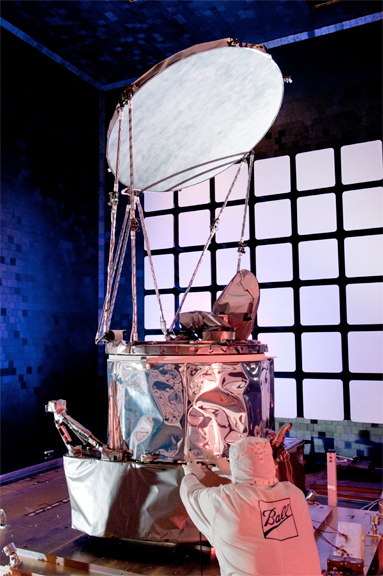[SatNews] The Global Precipitation Measurement (GPM) mission Core Satellite’s Microwave Imager (GMI), built by Ball Aerospace & Technologies Corp. under contract for NASA, has performed flawlessly in its first year on orbit as the most accurately calibrated radiometer in the 12-satellite GPM constellation.
The NASA Precipitation Measurement X-Cal working group noted the radiometer’s accuracy after analyzing GMI’s performance during its first year of operation. GMI launched February 27, 2014, aboard the joint NASA and Japan Aerospace Exploration Agency Global Precipitation Measurement mission's Core Observatory. GMI provides a standard of calibration that will substantially improve the accuracy of the precipitation data measured by other radiometers in the constellation.

Ball’s Microwave Imager is on track as the best calibrated radiometer in the GPM constellation.
Photo courtesy of Ball Aerospace.
The Ball Aerospace GMI engineering design features a radio frequency (RF) receiver subsystem that is highly temperature stable, including a shade that protects the instrument electronics from the sun’s heat. This helps prevent high temperatures from compromising the calibration accuracy of the instrument. GMI also features two standard calibration points, one at the cold end of the temperature range and one at the high end. As GMI spins at 32 revolutions per minute, it continuously self-calibrates so it can accurately measure Earth’s brightness temperatures. A special coating on GMI’s main reflector collects and channels RF energy so that the high frequency channel data are not compromised. GMI is the first radiometer to use noise diodes at specific frequencies to provide a 4-point calibration system that enhances accuracy.
As an essential part of an international satellite mission, the Ball Aerospace GMI is capturing next-generation observations of rain and snow worldwide every three hours. The GPM Core Observatory is delivering unprecedented 3-D views of hurricanes and snowstorms and contributes to monitoring and forecasting weather events such as droughts, floods and landslides.
GMI is one example of Ball’s long support of the country’s weather observation and climate science. The GPM constellation includes the Ball Aerospace-built Suomi National Polar-orbiting Partnership (NPP) satellite, which launched in 2011, and will include the first Joint Polar Satellite System, currently in development at Ball meeting cost and schedule requirements. Both satellites enable faster, more accurate weather forecasting.
“The Ball GMI enhanced subsystems design enables excellent science data performance with calibration accuracy that is unparalleled,” said Jim Oschmann, vice president and general manager of Ball’s Civil Space and Technology business unit. “GMI incorporates lessons learned from other radiometers which have taken Earth science measurements from low and medium Earth orbits for the last 20 years.”


